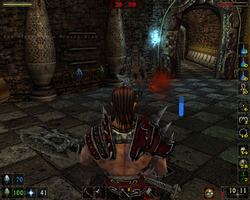Game Design Essentials - 20 RPGs in 22 Pages
Game Design Essentials - 20 RPGs in 22 Pages
Editorial - posted by Jason on Fri 3 July 2009, 22:19:48
Tags: Wizardry: Proving Grounds of the Mad OverlordJohn Harris took a break from his @Play column to throw down a 22 page article for Gamasutra, Game Design Essentials: 20 RPGs, wherein he pokes at the innards of 10 western RPGs and 10 of the Japanese variety.
Even though there are many scripted encounters, or "specials," a key difference between Wizardry and the D&D sessions it seeks to emulate is the absence of a flexible DM to allow the players to try things that aren't offered in the basic ruleset. There is no jumping up on tables, swinging from ropes, prodding with 10-foot poles, knocking on walls, or listening at doors or using them to block pursuers. Monsters don't exist until they have been triggered, and once a fight begins it takes place entirely in that square of dungeon map, and cannot sprawl out into the dungeon.
It is important to note that, in the 25-plus years since Wizardry was released, no CRPG has satisfactorily addressed this limitation, that of system inflexibilty. The lack of verisimilitude remains the most grievous difference between them and pen-and-paper games.The article is worth a read, even the JRPG parts (there's a section on Earthbound), although some folks will point and laugh at this bit in the Baldur's Gate section:
Finally, I don't think I can let this game pass by without noting the extremely well-done characterization of the potential party characters. I am not aware of anyone who has played this game who had a certain ranger named Minsc join his party who wasn't utterly enthralled by the character.
Even though there are many scripted encounters, or "specials," a key difference between Wizardry and the D&D sessions it seeks to emulate is the absence of a flexible DM to allow the players to try things that aren't offered in the basic ruleset. There is no jumping up on tables, swinging from ropes, prodding with 10-foot poles, knocking on walls, or listening at doors or using them to block pursuers. Monsters don't exist until they have been triggered, and once a fight begins it takes place entirely in that square of dungeon map, and cannot sprawl out into the dungeon.
It is important to note that, in the 25-plus years since Wizardry was released, no CRPG has satisfactorily addressed this limitation, that of system inflexibilty. The lack of verisimilitude remains the most grievous difference between them and pen-and-paper games.
Finally, I don't think I can let this game pass by without noting the extremely well-done characterization of the potential party characters. I am not aware of anyone who has played this game who had a certain ranger named Minsc join his party who wasn't utterly enthralled by the character.
There are 19 comments on Game Design Essentials - 20 RPGs in 22 Pages














